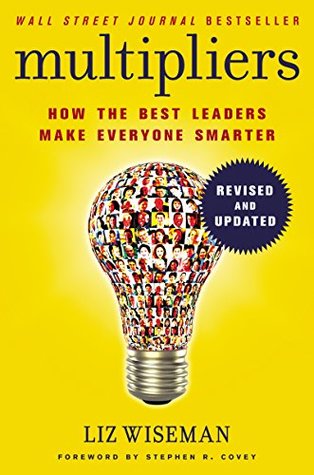More on this book
Community
Kindle Notes & Highlights
As you read, you will find a few central messages: 1. Diminishers underutilize people and leave capability on the table. 2. Multipliers increase intelligence in people and in organizations. People actually get smarter and more capable around them. 3. Multipliers leverage their resources. Corporations can get 2× more from their resources by turning their most intelligent resources into intelligence Multipliers.
Although the Multiplier/Diminisher framework might appear binary, I wish to emphasize that there is a continuum between Multipliers and Diminishers, with just a small number of people at either polar extreme.
Throughout the book she talks about behavior which can be learned and changed, but she's using the language of "be" you ARE a multiplier or a diminisher. In other words, while she says there is a continuum, she writes as if the choice is either/or.
In this spirit, I challenge you to read this book on several levels. At the most fundamental level, it might illuminate what you undoubtedly have experienced—that some leaders create genius, while others destroy it. Or you might go beyond this and reflect on the quintessential Multipliers and Diminishers who have been part of your career and life experience. But perhaps the best way to approach the book is to look beyond the idea that you or your colleagues are Multipliers, and instead spot yourself at times in the guise of Diminisher. The greatest power of these ideas might be in realizing
...more
Chapter One Summary Multipliers Versus Diminishers MULTIPLIERS: These leaders are genius makers who bring out the intelligence in others. They build collective, viral intelligence in organizations. DIMINISHERS: These leaders are absorbed in their own intelligence, stifle others, and deplete the organization of crucial intelligence and capability. The Five Disciplines of the Multipliers 1. The Talent Magnet: Attracts and optimizes talent 2. The Liberator: Requires people’s best thinking 3. The Challenger: Extends challenges 4. The Debate Maker: Debates decisions 5. The Investor: Instills
...more
Chapter Two Summary The Empire Builder Versus the Talent Magnet EMPIRE BUILDERS bring in great talent, but they underutilize it because they hoard resources and use them only for their own gain. TALENT MAGNETS get access to the best talent because people flock to work for them, knowing they will be fully utilized and developed to be ready for the next stage. The Four Practices of the Talent Magnet 1. Look for Talent Everywhere • Appreciate all types of genius • Ignore boundaries 2. Find People’s Native Genius • Look for what is native • Label it 3. Utilize People to Their Fullest
...more
People’s best thinking must be given, not taken.
Chapter Three Summary The Tyrant Versus the Liberator TYRANTS create a tense environment that suppresses people’s thinking and capability. As a result, people hold back, bring up safe ideas that the leader agrees with, and work cautiously. LIBERATORS create an intense environment that requires people’s best thinking and work. As a result, people offer their best and boldest thinking and give their best effort. The Three Practices of the Liberator 1. Create Space • Release others by restraining yourself • Shift the ratio of listening to talking • Define a space for discovery • Level the
...more
Chapter Four Summary The Know-It-All Versus the Challenger KNOW-IT-ALLS give directives that showcase how much they know. As a result they limit what their organization can achieve to what they themselves know how to do. The organization uses its energy to deduce what the boss thinks. CHALLENGERS define opportunities that challenge people to go beyond what they know how to do. As a result they get an organization that understands the challenge and has the focus and energy to take it on. The Three Practices of the Challenger 1. Seed the Opportunity • Show the need • Challenge the assumptions
...more
question. Tim Brown, chief executive and president of IDEO, the famously innovative global design consultancy firm, said: As leaders, probably the most important role we can play is asking the right questions and focusing on the right problems. It’s very easy in business to get sucked into being reactive to the problems and questions that are right in front of you. It doesn’t matter how creative you are as a leader, it doesn’t matter how good the answers you come up with. If you’re focusing on the wrong questions, you’re not really providing the leadership you should.4
savvy. While leading like a Multiplier might be management science, dealing with Diminishers is an art form. But done thoughtfully and persistently, you might even find that you become immune to the effects of diminishing leaders. Ultimately, you might join the ranks of those I call Invincibles—people who continue to work using their highest capacity and offer their greatest intelligence, despite being surrounded by diminishing behaviors.


